Regulatory Impact Statement for the 2005 Minimum Wage Review
Regulatory Impact Statement for the 2005 Minimum Wage Review
Regulatory Impact Statement for the 2005 Minimum Wage Review
Create successful ePaper yourself
Turn your PDF publications into a flip-book with our unique Google optimized e-Paper software.
REGULATORY IMPACT STATEMENT<br />
<strong>Statement</strong> of <strong>the</strong> nature and magnitude of <strong>the</strong> problem and <strong>the</strong> need <strong>for</strong><br />
government action<br />
Subsection 5(1) of <strong>the</strong> <strong>Minimum</strong> <strong>Wage</strong> Act 1983 states that “The Minister of<br />
Labour shall, in each year ending on <strong>the</strong> 31 st day of December, review any<br />
minimum rate prescribed pursuant to section 4 of this Act”. The current specified<br />
minimum rate <strong>for</strong> people aged 18 years and over (<strong>the</strong> “adult” rate) is $9.50 per<br />
hour and <strong>for</strong> those aged 16 or 17 years (<strong>the</strong> “youth” rate is 80% of <strong>the</strong> adult rate,<br />
or $7.60 per hour) <strong>the</strong>re<strong>for</strong>e need to be reviewed by 31 December <strong>2005</strong>.<br />
<strong>Minimum</strong> wage rates provide a minimum acceptable standard <strong>for</strong> pay rates, and<br />
<strong>the</strong>re<strong>for</strong>e are particularly relevant to <strong>the</strong> low paid.<br />
Women, Maori and Pacific Island people and young people are over-represented<br />
among minimum wage earners, and would expect to benefit from increases in <strong>the</strong><br />
minimum wage. Changes in <strong>the</strong> minimum wage particularly affect <strong>the</strong><br />
agricultural, accommodation and catering and retail trades sectors, and small and<br />
medium enterprises.<br />
The training minimum wage was introduced in July 2003 and allows <strong>for</strong> a lower<br />
minimum wage (at 80% of <strong>the</strong> adult rate) to be paid if an employee is undertaking<br />
training of at least 60 credits annually towards a qualification registered by <strong>the</strong><br />
National Qualifications Framework.<br />
The minimum wage was last increased on 21 March <strong>2005</strong>. Since <strong>the</strong>n, consumer<br />
prices have increased by 2.8% and average hourly earnings have increased by<br />
3.5% (<strong>for</strong> <strong>the</strong> year to June <strong>2005</strong>) resulting in a decrease in <strong>the</strong> real value of <strong>the</strong><br />
minimum wage. Benefit rates are indexed to <strong>the</strong> Consumer Price Index, (and<br />
have <strong>the</strong>re<strong>for</strong>e increased at that rate) so <strong>the</strong> incentive <strong>for</strong> some people to work<br />
may have reduced. The current unemployment level is 3.4% <strong>for</strong> <strong>the</strong> overall<br />
population aged 18 years or over (September Quarter <strong>2005</strong>).<br />
<strong>Statement</strong> of <strong>the</strong> public policy objective(s)<br />
The minimum wage is part of <strong>the</strong> government’s general responsibility to ensure<br />
socially acceptable employment standards that are prescribed and en<strong>for</strong>ceable.<br />
In addition, <strong>the</strong>re are <strong>for</strong>mal international commitments that establish an explicit<br />
obligation on <strong>the</strong> government to ensure an adequate minimum wage, including<br />
under ILO Convention 26 which obliges <strong>the</strong> government to create minimum wage<br />
fixing machinery where "no arrangements exist <strong>for</strong> <strong>the</strong> effective regulation of<br />
wages…and wages are exceptionally low", and recommends that minimum<br />
wages should be set according to <strong>the</strong> "general level of wages prevailing in <strong>the</strong><br />
country".<br />
The government’s objectives <strong>for</strong> <strong>the</strong> minimum wage are:<br />
A. to ensure that wages paid are no lower than a socially acceptable minimum<br />
(fairness). Changes to reflect average wages or inflation are relevant <strong>for</strong><br />
maintaining this objective.
B. to offer wage protection to vulnerable workers (protection)<br />
C. to ensure that incomes of people on low incomes do not deteriorate relative to<br />
those of o<strong>the</strong>r workers (income distribution)<br />
D. to increase <strong>the</strong> incentives to work <strong>for</strong> people considering work who are not<br />
currently in paid employment (work incentives).<br />
The government has also announced an aspirational goal of reaching $12 an<br />
hour (<strong>for</strong> adults) by <strong>the</strong> end of 2008, if economic conditions permit. The Minister<br />
of Labour will make an announcement about <strong>the</strong> path to reach <strong>the</strong> government’s<br />
goal at <strong>the</strong> same time as an announcement is made about <strong>the</strong> outcome of this<br />
year’s review. However, an identified path will be indicative only, and will be<br />
confirmed following fur<strong>the</strong>r minimum wage reviews, if economic conditions<br />
permit. Changes will be announced in advance, however, to allow businesses<br />
time to adjust.<br />
Changes would not come into effect until March to allow employers time to adjust<br />
to <strong>the</strong> change. Annual adjustments to reach <strong>the</strong> government’s aspirational goal<br />
of $12 an hour (adult rate) by <strong>the</strong> end of 2008, if economic conditions permit, will<br />
continue to be subject to an annual review.<br />
<strong>Statement</strong> of feasible options (regulatory and/or non-regulatory) that may<br />
constitute viable means <strong>for</strong> achieving <strong>the</strong> desired objectives(s) AND<br />
<strong>Statement</strong> of <strong>the</strong> net benefit of <strong>the</strong> proposal, including <strong>the</strong> total regulatory<br />
costs (administrative, compliance and economic costs) and benefits<br />
(including non-quantifiable benefits) of <strong>the</strong> proposal, and o<strong>the</strong>r feasible<br />
options.<br />
Options <strong>for</strong> <strong>the</strong> 2006 adjustment (or first step towards <strong>the</strong> goal of $12 an hour)<br />
Seven options <strong>for</strong> <strong>the</strong> adult minimum wage have been considered. Tables 1 and<br />
2 below indicate total numbers of adults and youth affected by each of <strong>the</strong><br />
minimum wage options. <strong>Minimum</strong> wage changes would come into effect on<br />
Monday 27 March 2006.<br />
Table 1: <strong>Impact</strong> of Adult (18 years and over) <strong>Minimum</strong> <strong>Wage</strong><br />
Option<br />
<strong>for</strong><br />
2006<br />
1<br />
Hourly rate<br />
$9.50<br />
Weekly rate<br />
$380<br />
Cumulative no. of people<br />
who would receive a wage<br />
rise and percentage of<br />
employees 0 cohor(cumulative)<br />
2A $9.83 $393 24,900 (1.6%)<br />
2B $10.00 $400 28,400 (1.8%)<br />
3A $10.13 $405 86,140 (5.6%)<br />
3B $10.25 $408 91,000 (5.7%)<br />
3C $10.50 $420 103,500 (6.5%)<br />
4 $12.00 $480 246,600 (15.5%)<br />
Table 2: <strong>Impact</strong> of Youth (16 and 17 years) <strong>Minimum</strong> <strong>Wage</strong>
Option <strong>for</strong><br />
2006<br />
Hourly rate<br />
Weekly<br />
rate<br />
1 $7.60 $304 0<br />
2A $7.86 $315 3,500 (5.8%)<br />
2B $8.00 $320 3,700 (6.3%)<br />
3A $8.10 $324 9,420 (18.6%)<br />
3B $8.20 $328 10,000 (16.9%)<br />
3C $8.40 $336 11,000 (18.7%)<br />
4 $9.60 $384 24,700 (41.8%)<br />
Cumulative no. of people who<br />
would receive a wage rise and<br />
percentage of youth work<strong>for</strong>ce<br />
Status quo – Option 1: leaving <strong>the</strong> minimum wage unchanged at $9.50<br />
($7.60 <strong>for</strong> youth and trainees)<br />
Leaving <strong>the</strong> minimum wage unchanged would not require any adjustment by<br />
employers. However, it would mean that <strong>the</strong> minimum wage would decrease in<br />
real terms, and relative to average wages. There would also be a reduction in <strong>the</strong><br />
margin between benefit rates (which increase by <strong>the</strong> rate of inflation each April)<br />
and <strong>the</strong> minimum wage, which may reduce incentives <strong>for</strong> some people to work.<br />
The current minimum wage is 90.4% higher than <strong>the</strong> unemployment benefit (<strong>for</strong> a<br />
single adult with no supplementary assistance included).<br />
Retaining <strong>the</strong> existing minimum wage ($9.50 per hour) will erode <strong>the</strong> real value of<br />
<strong>the</strong>se wages and would not fur<strong>the</strong>r contribute to <strong>the</strong> government’s objectives <strong>for</strong><br />
<strong>the</strong> minimum wage.<br />
Increasing <strong>the</strong> minimum wage by a relatively small amount (Option 2A by<br />
3.5% to $9.83, and option 2B by 5.3% to $10.00)<br />
A small increase equivalent to <strong>the</strong> increase in average wages (to around $9.83),<br />
and an increase in line with recent annual fifty cent an hour increases (to $10.00<br />
an hour) would be consistent with <strong>the</strong> Government’s concern that <strong>the</strong> minimum<br />
wage should not lose its value over time. It would also contribute to <strong>the</strong> fairness<br />
and income protection objectives of <strong>the</strong> minimum wage. An increase of at least<br />
<strong>the</strong> rate of inflation would also preserve <strong>the</strong> margin between benefit rates and <strong>the</strong><br />
minimum wage (relevant to <strong>the</strong> work incentives objective). The slightly larger<br />
increase proposed in this option would increase <strong>the</strong> margin between benefit rates<br />
and wages, and also increase <strong>the</strong> ratio of <strong>the</strong> minimum wage to <strong>the</strong> average<br />
wage.<br />
An increase in <strong>the</strong> minimum wage in 2006 to maintain relativity to average wages<br />
($9.83 per hour) will preserve <strong>the</strong> real value of <strong>the</strong> minimum wage and can be<br />
made with confidence in <strong>the</strong> current economic and labour market conditions. It<br />
would mean that larger increases would be required in future years to reach <strong>the</strong><br />
government’s aspirational goal of reach $12 an hour by <strong>the</strong> end of 2008 (adult<br />
rate), if economic conditions permit.
Increasing <strong>the</strong> minimum wage by a larger amount, ei<strong>the</strong>r Option 3A by 6.6%<br />
or $10.13, or Option 3B: by 7.9% to $10.25, Option 3C: by 10.5% to $10.50,<br />
or Option 4: by 26.3% to $12.00<br />
Those on low incomes could expect larger increases in <strong>the</strong>ir earnings as a result<br />
of a larger increase in <strong>the</strong> minimum wage. This would help to narrow <strong>the</strong> earnings<br />
distribution, although it could also create ‘flow on’ effects <strong>for</strong> firms as employees<br />
fur<strong>the</strong>r up <strong>the</strong> earnings distribution seek wage increases to preserve relativities.<br />
A larger increase in 2006 would require smaller increases in future years to reach<br />
<strong>the</strong> government’s aspirational goal of $12 an hour (adult rate) by <strong>the</strong> end of 2008,<br />
if economic conditions permit.<br />
A larger increase in <strong>the</strong> minimum wage could also lead to business seeking to<br />
improve <strong>the</strong> productivity of lower wage workers. Evidence from <strong>the</strong> UK Low Pay<br />
Commission suggests that a significant proportion of businesses adjusted to <strong>the</strong><br />
minimum wage by seeking to increase productivity of <strong>the</strong>ir workers. Firms also<br />
responded by exercising tighter control on labour costs (including reducing<br />
employment and hours worked), and some ‘positive’ adjustments such as<br />
changing work organisation, increasing investment in training and development,<br />
improved quality of service, and increased use of technology.<br />
A rate over $10 an hour (e.g. $10.25 or $10.50 an hour) would exceed <strong>the</strong> recent<br />
trends of fifty cents an hour increases and so would signal a stronger message in<br />
2006 about a commitment to reach <strong>the</strong> government’s aspirational goal. An<br />
increase over $10.50 an hour could also mean a higher risk that <strong>the</strong> rate of<br />
growth of minimum wage jobs would slow, especially if <strong>the</strong>re is a downturn in <strong>the</strong><br />
economy or a fur<strong>the</strong>r softening in economic conditions.<br />
Youth and training minimum wage rates <strong>for</strong> 2006<br />
The recommended option <strong>for</strong> 2006 is that <strong>the</strong> youth and training minimum wage<br />
rates retain <strong>the</strong>ir current relativity with <strong>the</strong> adult rate (at 80% of <strong>the</strong> adult rate).<br />
Young people report higher levels of non-compliance with <strong>the</strong> youth minimum<br />
wage and a large increase in <strong>the</strong> youth rate (irrespective of its relativity with <strong>the</strong><br />
adult rate) may result in a corresponding rise in reported non-compliance <strong>for</strong> this<br />
group.<br />
Overall net impacts of an increase in <strong>the</strong> minimum wage<br />
Costs<br />
Unless <strong>the</strong>y are readily able to absorb <strong>the</strong> increased labour costs associated with<br />
an increased minimum wage, businesses will need to adjust to a minimum wage<br />
increase in some o<strong>the</strong>r way. The adjustment needed will be greater <strong>the</strong> larger<br />
<strong>the</strong> increase in <strong>the</strong> minimum wage. Those employees who would benefit from an<br />
increase in <strong>the</strong> minimum wage would also be <strong>the</strong> first to be affected by any costs,<br />
<strong>for</strong> example, through shortened working hours, <strong>the</strong> substitution of higher <strong>for</strong> lower<br />
skilled workers, delayed employment decisions, reduced non-wage terms and<br />
conditions, increased pressure on worker productivity, or reduced training.<br />
Sectors most likely to be affected will be agriculture, accommodation and<br />
catering, and retail sectors. Small firms are also more likely to be affected than<br />
larger firms.
The impact on costs to government is unclear, but likely to be small. There are a<br />
number of state sector employees (and contractors) that earn wages of $12 per<br />
hour or less, particularly in <strong>the</strong> public health and compulsory education sectors.<br />
Future increases in <strong>the</strong> minimum wage are <strong>the</strong>re<strong>for</strong>e likely to have direct (and<br />
possibly also indirect or ‘flow-on') costs <strong>for</strong> some state sector employers. These<br />
costs and <strong>the</strong> likelihood that organisations will seek additional funding to<br />
compensate <strong>for</strong> <strong>the</strong>m, will be higher <strong>for</strong> larger movements towards <strong>the</strong><br />
aspirational goal of $12 per hour.<br />
Benefit payments may increase <strong>for</strong> people who have <strong>the</strong>ir hours of work reduced,<br />
but <strong>for</strong> those who receive wage increases; <strong>the</strong>re may be some offsetting benefit<br />
abatement. There will also be a small increase in tax paid by people who receive<br />
pay rises. Overall, <strong>the</strong>se factors mean <strong>the</strong> direct fiscal impacts are likely to be<br />
small however, detailed estimates of <strong>the</strong>se costs and off-setting benefits have not<br />
been prepared.<br />
If wage increases are contained to those moving up to <strong>the</strong> new minimum wage,<br />
<strong>the</strong> impact on prices is likely to be small. Businesses who are affected by<br />
minimum wage increases have suggested that <strong>the</strong>y may adjust by passing on <strong>the</strong><br />
cost of wage rises to customers by increases prices.<br />
Compliance costs arising out of any increase in <strong>the</strong> minimum wage are detailed<br />
in <strong>the</strong> Business Compliance Cost <strong>Statement</strong>.<br />
Benefits<br />
Any increase in <strong>the</strong> minimum wage will mean that some low-wage workers will<br />
receive wage increases ensuring that <strong>the</strong>ir earnings do not deteriorate relative to<br />
o<strong>the</strong>r workers. There may also be flow-on effects to <strong>the</strong> wages of some workers<br />
above <strong>the</strong> minimum wage, as <strong>the</strong>y seek to maintain wage relativities. If <strong>the</strong><br />
margin between wages and benefit rates is increased through a minimum wage<br />
increase, <strong>the</strong> incentive to work relative to remaining on benefit is also increased.<br />
The benefits of minimum wage increases are likely to be felt most strongly among<br />
women, younger workers, Maori, Pacific peoples, people with disabilities, recent<br />
migrants, <strong>the</strong> low skilled and people with non-English speaking backgrounds.<br />
These groups would, however also be more likely to experience any negative<br />
impacts that could result from a minimum wage increase, particularly if <strong>the</strong>re was<br />
a big increase (<strong>for</strong> example, reduced hours worked, or substitution of some<br />
groups of workers by o<strong>the</strong>rs).<br />
Fifty percent of low wage workers work part-time. Because of this, any increase<br />
in weekly incomes will reflect <strong>the</strong> fewer hours worked by low wage workers and<br />
will reduce <strong>the</strong> absolute increase in income arising from minimum wage<br />
increases.<br />
For some groups of women, an increase in <strong>the</strong> minimum wage is <strong>the</strong> only direct<br />
lever <strong>the</strong> government has to ensure an adequate earned income (<strong>the</strong>y may be<br />
non-unionised and/or, have weak bargaining power). Increasing <strong>the</strong> minimum<br />
wage will also play a small role in reducing <strong>the</strong> gender pay gap. The objectives<br />
sought through <strong>the</strong> minimum wage of improving levels of fairness and protection<br />
are particularly relevant <strong>for</strong> <strong>the</strong>se groups of more vulnerable women.
Increasing <strong>the</strong> minimum wage can make a small contribution to reducing <strong>the</strong><br />
gender pay gap. For example an increase in <strong>the</strong> minimum wage from $9.50 to<br />
$10.50 will improve <strong>the</strong> gender pay ratio by three tenths of a percentage point<br />
(0.3) to 82.1%.<br />
Of those receiving <strong>the</strong> youth minimum wage, <strong>the</strong> beneficiaries are likely to be<br />
youth who are working while still at school (75% of 16 and 17 year olds are still at<br />
school or in some <strong>for</strong>m of study) and <strong>the</strong>se workers are likely to be in <strong>the</strong> retail<br />
sector (64% of 16 and 17 year olds are employed in <strong>the</strong> retail industry). For<br />
youth, <strong>the</strong> increase in weekly income from an increase in <strong>the</strong> minimum wage is<br />
likely to be small, because <strong>the</strong> majority of young people work short hours.<br />
There may be savings to government through abated income assistance as a<br />
result of increased earned income <strong>for</strong> people in receipt of such assistance<br />
(including Working <strong>for</strong> Families assistance). However, despite abated income<br />
assistance, people will still be better off as a result of <strong>the</strong> increases to <strong>the</strong>ir<br />
wages.<br />
<strong>Statement</strong> of consultation undertaken<br />
Submissions <strong>for</strong> <strong>the</strong> <strong>2005</strong> <strong>Minimum</strong> <strong>Wage</strong> <strong>Review</strong> were received from a number<br />
of organisations reflecting women’s interests (<strong>the</strong> National Advisory Council on<br />
<strong>the</strong> Employment of Women) and worker (New Zealand Council of Trade Unions<br />
and Youth Union Movement) and business interests (Business New Zealand, <strong>the</strong><br />
NZ Retailers Association, The Hospitality Association, <strong>the</strong> Federation of Farmers,<br />
and New Zealand Association of Retail Grocers and Supermarkets and <strong>the</strong> Small<br />
Business Advisory Group). In addition, <strong>the</strong> Department of Labour met separately<br />
with <strong>the</strong> New Zealand Council of Trade Unions, Business New Zealand and <strong>the</strong><br />
Small Business Advisory Group to discuss some of <strong>the</strong> key issues relating to <strong>the</strong>ir<br />
submissions. Submissions representing employer interests, emphasised <strong>the</strong><br />
costs of wage increases (refer above) and sought no or small increases in<br />
minimum wages. Employee representatives recommended large increases in <strong>the</strong><br />
minimum wage, emphasising <strong>the</strong> benefits to low waged workers.<br />
The Treasury, Ministries of Education, Women’s Affairs, Pacific Island Affairs,<br />
Social Development, Economic Development, and Youth Development, Te Puni<br />
Kokiri, Tertiary Education Commission, <strong>the</strong> Office <strong>for</strong> Disability Issues, and <strong>the</strong><br />
Department of <strong>the</strong> Prime Minister and Cabinet have been consulted on <strong>the</strong> <strong>2005</strong><br />
<strong>Minimum</strong> <strong>Wage</strong> <strong>Review</strong>.<br />
The Ministry of Social Development (MSD), <strong>the</strong> Treasury and <strong>the</strong> Ministry of<br />
Economic Development have raised concerns that larger increases in minimum<br />
wage rates, which would directly affect a considerably larger number of workers<br />
than have been affected by previous increases, involve risks of a significant<br />
reduction in employment opportunities, particularly <strong>for</strong> vulnerable groups, and of<br />
wider economic losses. The extent of <strong>the</strong>se potential losses cannot be quantified,<br />
however, <strong>the</strong>se negative effects will be exacerbated if current buoyant economic<br />
and labour market conditions soften.<br />
These risks have been noted in <strong>the</strong> <strong>2005</strong> <strong>Minimum</strong> <strong>Wage</strong> <strong>Review</strong>. The<br />
Department of Labour considers that, given current economic and labour market<br />
conditions, an increase in <strong>the</strong> minimum wage above <strong>the</strong> rate needed to maintain
elativity to <strong>the</strong> average wage (e.g. $10 an hour or more) could be made to reflect<br />
a stronger view of <strong>the</strong> contribution of <strong>the</strong> minimum wage to its objectives. An<br />
increase over $10.50 an hour could, however, mean a higher risk that <strong>the</strong> rate of<br />
growth of minimum wage jobs would slow, especially if <strong>the</strong>re is a downturn in <strong>the</strong><br />
economy or a fur<strong>the</strong>r softening in economic conditions.<br />
MSD has also noted a concern that much of <strong>the</strong> re-distributional gains from gross<br />
increases in <strong>the</strong> minimum wage <strong>for</strong> low paid workers and low income families will<br />
be limited. MSD observes that in <strong>the</strong> current post-Working <strong>for</strong> Families<br />
environment raising <strong>the</strong> minimum wage is not a particularly effective way to<br />
improve <strong>the</strong> take home income of poor working families. The Department of<br />
Labour and MSD will undertake fur<strong>the</strong>r research to better understand <strong>the</strong><br />
interface between minimum wage increases and Working <strong>for</strong> Families.<br />
Business compliance cost statement<br />
This statement is based on <strong>the</strong> assumption that <strong>the</strong> minimum wage will be<br />
increased – <strong>the</strong>re will be no incremental compliance costs if <strong>the</strong> minimum wage is<br />
left unchanged.<br />
Changes to minimum wages require firms that currently pay less than <strong>the</strong> new<br />
minimum wage to <strong>the</strong>ir employees to raise those wages from <strong>the</strong> time that <strong>the</strong><br />
new minimum wage rates come into <strong>for</strong>ce. This adjustment will require minor<br />
changes to data in payroll systems, but o<strong>the</strong>rwise, <strong>the</strong> regulatory requirements<br />
remain unchanged by changing minimum wage rates. There may be compliance<br />
costs <strong>for</strong> employers adjusting to an increased minimum wage and <strong>the</strong>se<br />
adjustments are likely to disproportionately affect small businesses because<br />
small businesses employ proportionally large numbers of minimum wage earners<br />
and tend to offer a narrow wage band (so flow on effects my occur). Early notice<br />
of an increase will reduce <strong>the</strong>se costs. These costs may change depending on<br />
<strong>the</strong> particular path taken to achieve <strong>the</strong> government’s goal of $12 an hour.<br />
Employers employing workers who are paid less than <strong>the</strong> new minimum wage<br />
rates will be affected. In<strong>for</strong>mation from <strong>the</strong> July 2004 to June <strong>2005</strong> Statistics New<br />
Zealand Household Labour Force Survey Income Supplement suggests that<br />
<strong>the</strong>se employers are most likely to be in agriculture and agricultural services,<br />
parts of manufacturing (food, beverage and tobacco; textiles, clothing, footwear<br />
and lea<strong>the</strong>r), retail trades, restaurants and hotels, business services, education<br />
and health and community services.<br />
The Minister of Labour will undertake a communications strategy to outline <strong>the</strong><br />
changes to minimum wage rates. Changes would not come into effect until March to<br />
allow


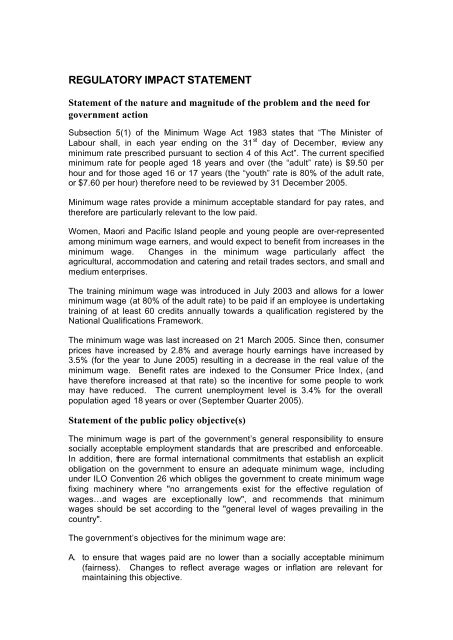
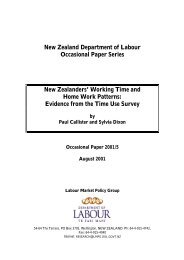

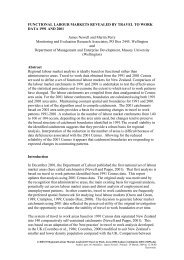
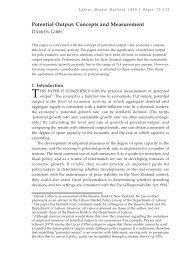

![a note on levels, trends, and some implications [pdf 21 pages, 139KB]](https://img.yumpu.com/27285836/1/184x260/a-note-on-levels-trends-and-some-implications-pdf-21-pages-139kb.jpg?quality=85)

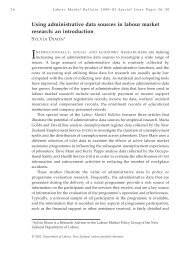
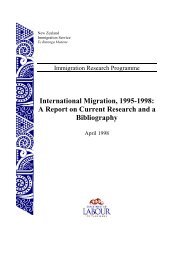
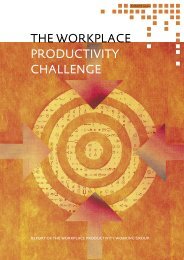
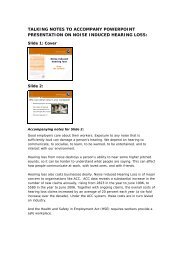
![Labour Market Trends and Outlook - 1996 [pdf 18 pages, 94KB]](https://img.yumpu.com/27285764/1/184x260/labour-market-trends-and-outlook-1996-pdf-18-pages-94kb.jpg?quality=85)

